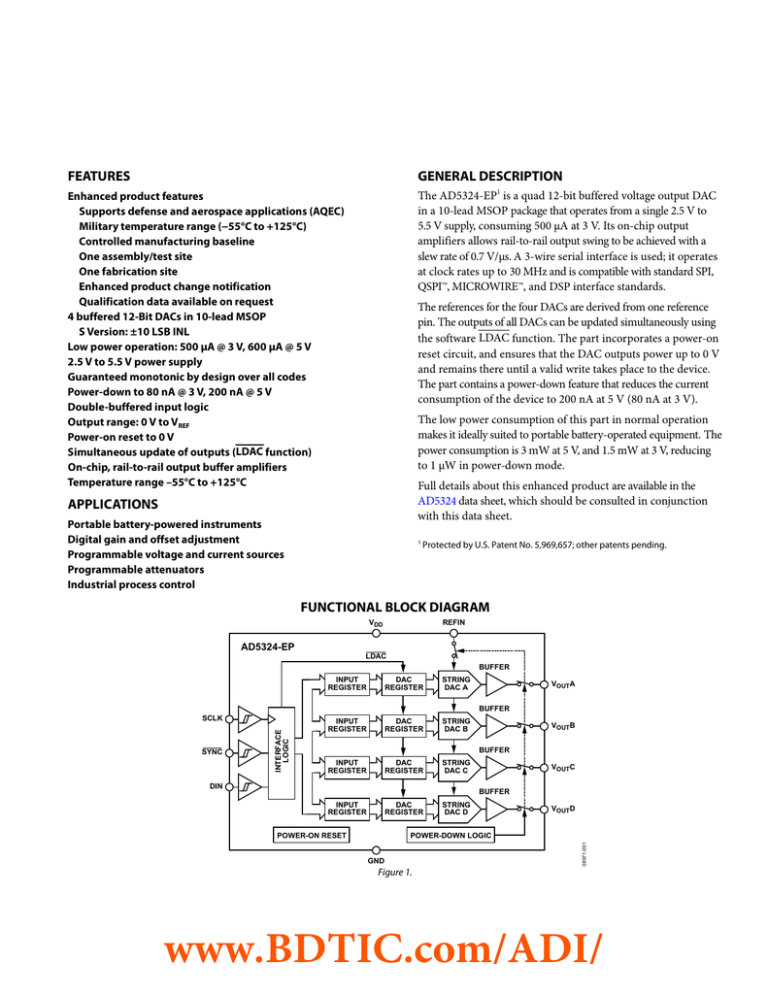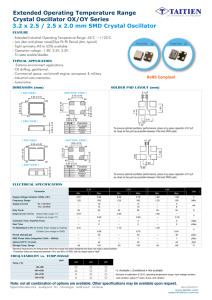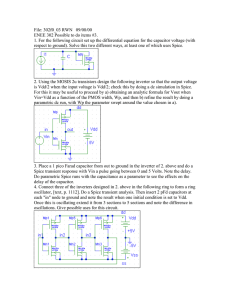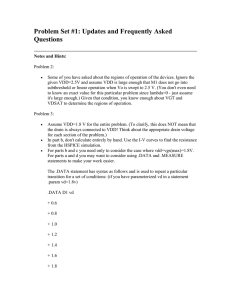
FEATURES
GENERAL DESCRIPTION
Enhanced product features
Supports defense and aerospace applications (AQEC)
Military temperature range (−55°C to +125°C)
Controlled manufacturing baseline
One assembly/test site
One fabrication site
Enhanced product change notification
Qualification data available on request
4 buffered 12-Bit DACs in 10-lead MSOP
S Version: ±10 LSB INL
Low power operation: 500 μA @ 3 V, 600 μA @ 5 V
2.5 V to 5.5 V power supply
Guaranteed monotonic by design over all codes
Power-down to 80 nA @ 3 V, 200 nA @ 5 V
Double-buffered input logic
Output range: 0 V to VREF
Power-on reset to 0 V
Simultaneous update of outputs (LDAC function)
On-chip, rail-to-rail output buffer amplifiers
Temperature range –55°C to +125°C
The AD5324-EP1 is a quad 12-bit buffered voltage output DAC
in a 10-lead MSOP package that operates from a single 2.5 V to
5.5 V supply, consuming 500 μA at 3 V. Its on-chip output
amplifiers allows rail-to-rail output swing to be achieved with a
slew rate of 0.7 V/μs. A 3-wire serial interface is used; it operates
at clock rates up to 30 MHz and is compatible with standard SPI,
QSPI™, MICROWIRE™, and DSP interface standards.
The references for the four DACs are derived from one reference
pin. The outputs of all DACs can be updated simultaneously using
the software LDAC function. The part incorporates a power-on
reset circuit, and ensures that the DAC outputs power up to 0 V
and remains there until a valid write takes place to the device.
The part contains a power-down feature that reduces the current
consumption of the device to 200 nA at 5 V (80 nA at 3 V).
The low power consumption of this part in normal operation
makes it ideally suited to portable battery-operated equipment. The
power consumption is 3 mW at 5 V, and 1.5 mW at 3 V, reducing
to 1 μW in power-down mode.
Full details about this enhanced product are available in the
AD5324 data sheet, which should be consulted in conjunction
with this data sheet.
APPLICATIONS
Portable battery-powered instruments
Digital gain and offset adjustment
Programmable voltage and current sources
Programmable attenuators
Industrial process control
1
Protected by U.S. Patent No. 5,969,657; other patents pending.
FUNCTIONAL BLOCK DIAGRAM
VDD
REFIN
AD5324-EP
LDAC
BUFFER
INPUT
REGISTER
DAC
REGISTER
STRING
DAC A
INPUT
REGISTER
DAC
REGISTER
STRING
DAC B
INPUT
REGISTER
DAC
REGISTER
STRING
DAC C
INPUT
REGISTER
DAC
REGISTER
STRING
DAC D
VOUTA
BUFFER
VOUTB
BUFFER
DIN
VOUTC
BUFFER
POWER-ON RESET
VOUTD
POWER-DOWN LOGIC
GND
08971-001
SYNC
INTERFACE
LOGIC
SCLK
Figure 1.
www.BDTIC.com/ADI/
TABLE OF CONTENTS
Features .............................................................................................. 1
Timing Characteristics .................................................................5
Applications ....................................................................................... 1
Absolute Maximum Ratings ............................................................6
General Description ......................................................................... 1
ESD Caution...................................................................................6
Functional Block Diagram .............................................................. 1
Pin Configuration and Function Descriptions..............................7
Revision History ............................................................................... 2
Typical Performance Characteristics ..............................................8
Specifications..................................................................................... 3
Outline Dimensions ....................................................................... 11
AC Characteristics ........................................................................ 4
Ordering Guide .......................................................................... 11
REVISION HISTORY
4/10—Revision 0: Initial Version
www.BDTIC.com/ADI/
SPECIFICATIONS
VDD = 2.5 V to 5.5 V; VREF = 2 V; RL = 2 kΩ to GND; CL = 200 pF to GND; all specifications TMIN to TMAX, unless otherwise noted.
Table 1.
Parameter
DC PERFORMANCE1
Resolution
Relative Accuracy
Differential Nonlinearity2
Offset Error
Gain Error
Lower Dead Band
Offset Error Drift3
Gain Error Drift3
DC Power Supply Rejection Ratio3
DC Crosstalk3
DAC REFERENCE INPUTS3
VREF Input Range
VREF Input Impedance
Min
S Version
Typ
12
±2
±0.2
±0.4
±0.15
20
–12
–5
–60
200
0.25
37
Reference Feedthrough
OUTPUT CHARACTERISTICS3
Minimum Output Voltage4
Maximum Output Voltage4
DC Output Impedance
Short Circuit Current
VDD
45
>10
–90
LOGIC INPUTS3
Input Current
VIL, Input Low Voltage
Pin Capacitance
POWER REQUIREMENTS
VDD
IDD (Normal Mode)5
VDD = 4.5 V to 5.5 V
VDD = 2.5 V to 3.6 V
IDD (Power-Down Mode)
VDD = 4.5 V to 5.5 V
VDD = 2.5 V to 3.6 V
±10
±1
±3
±1
60
0.001
VDD – 0.001
0.5
25
16
2.5
5
Power-Up Time
VIH, Input High Voltage
Max
Unit
Bits
LSB
LSB
% of FSR
% of FSR
mV
ppm of FSR/°C
ppm of FSR/°C
dB
μV
V
kΩ
MΩ
dB
V
Ω
mA
mA
μs
μs
Conditions/Comments
Guaranteed monotonic by design over all codes
See Figure 2
See Figure 2
Lower dead band exists only if offset error is negative
ΔVDD = ±10%
RL = 2 kΩ to GND or VDD
Normal operation
Power-down mode
Frequency = 10 kHz
Measurement of the minimum and maximum
V drive capability of the output amplifier
VDD = 5 V
VDD = 3 V
Coming out of power-down mode VDD = 5 V
Coming out of power-down mode VDD = 3 V
±1
0.8
0.6
0.5
μA
V
V
V
V
V
V
pF
5.5
V
600
500
900
700
μA
μA
VIH = VDD and VIL = GND
VIH = VDD and VIL = GND
0.2
0.08
1
1
μA
μA
VIH = VDD and VIL = GND
VIH = VDD and VIL = GND
2.4
2.1
2.0
3
2.5
VDD = 5 V ± 10%
VDD = 3 V ± 10%
VDD = 2.5 V
VDD = 5 V ± 10%
VDD = 3 V ± 10%
VDD = 2.5 V
1
DC specifications tested with the outputs unloaded.
Linearity is tested using a reduced code range: Code 115 to Code 3981.
Guaranteed by design and characterization, not production tested.
4
For the amplifier output to reach its minimum voltage, offset error must be negative. For the amplifier output to reach its maximum voltage, VREF = VDD and offset plus
gain error must be positive.
5
IDD specification is valid for all DAC codes; interface inactive; all DACs active; load currents excluded.
2
3
www.BDTIC.com/ADI/
AC CHARACTERISTICS
VDD = 2.5 V to 5.5 V; RL = 2 kΩ to GND; CL = 200 pF to GND; all specifications TMIN to TMAX, unless otherwise noted.
Table 2.
1
Parameter
Output Voltage Settling Time
S Version2
Min
Typ
Max
Slew Rate
Major-Code Transition Glitch Energy
Digital Feedthrough
Digital Crosstalk
DAC-to-DAC Crosstalk
Multiplying Bandwidth
Total Harmonic Distortion
1
2
8
0.7
12
1
1
3
200
–70
10
Unit
μs
V/μs
nV-sec
nV-sec
nV-sec
nV-sec
kHz
dB
Conditions/Comments
VREF = VDD = 5 V
¼ scale to ¾ scale change (0x400 to 0xC00)
1 LSB change around major carry
VREF = 2 V ± 0.1 V p-p
VREF = 2.5 V ± 0.1 V p-p; frequency = 10 kHz
Guaranteed by design and characterization, not production tested.
Temperature range (S Version): −55°C to +125°C; typical at +25°C.
www.BDTIC.com/ADI/
TIMING CHARACTERISTICS
VDD = 2.5 V to 5.5 V; all specifications TMIN to TMAX, unless otherwise noted.
Table 3.
Parameter1, 2, 3
t1
t2
t3
t4
t5
t6
t7
t8
2
3
Unit
ns min
ns min
ns min
ns min
ns min
ns min
ns min
ns min
Conditions/Comments
SCLK cycle time
SCLK high time
SCLK low time
SYNC to SCLK falling edge setup time
Data setup time
Data hold time
SCLK falling edge to SYNC rising edge
Minimum SYNC high time
Guaranteed by design and characterization, not production tested.
All input signals are specified with tr = tf = 5 ns (10% to 90 % of VDD) and timed from a voltage level of (VIL + VIH)/2.
See Figure 2.
t1
SCLK
t8
t3
t4
t2
t7
SYNC
t6
DIN
DB15
t5
DB0
Figure 2. Serial Interface Timing Diagram
www.BDTIC.com/ADI/
00929-002
1
Limit at TMIN, TMAX
VDD = 2.5 V to 3.6 V
VDD = 3.6 V to 5.5 V
40
33
16
13
16
13
16
13
5
5
4.5
4.5
0
0
80
33
ABSOLUTE MAXIMUM RATINGS
TA = 25°C, unless otherwise noted.
Table 4.
Parameter1
VDD to GND
Digital Input Voltage to GND
Reference Input Voltage to GND
VOUTA through VOUTD to GND
Operating Temperature Range
Industrial (EP Version)
Storage Temperature Range
Junction Temperature (TJ max)
10-Lead MSOP
Power Dissipation
θJA Thermal Impedance
θJC Thermal Impedance
Reflow Soldering
Peak Temperature
Time at Peak Temperature
1
Rating
–0.3 V to +7 V
–0.3 V to VDD + 0.3 V
–0.3 V to VDD + 0.3 V
–0.3 V to VDD + 0.3 V
Stresses above those listed under Absolute Maximum Ratings
may cause permanent damage to the device. This is a stress
rating only; functional operation of the device at these or any
other conditions above those indicated in the operational
section of this specification is not implied. Exposure to absolute
maximum rating conditions for extended periods may affect
device reliability.
ESD CAUTION
–55°C to +125°C
–65°C to +150°C
150°C
(TJ max – TA)/ θJA
206°C/W
44°C/W
220°C
10 sec to 40 sec
Transient currents of up to 100 mA do not cause SCR latch-up.
www.BDTIC.com/ADI/
VDD 1
10
SYNC
VOUTA 2
9
SCLK
VOUTB 3
VOUTC 4
REFIN 5
AD5324-EP
TOP VIEW
(Not to Scale)
8
DIN
7
GND
6
VOUTD
08971-003
PIN CONFIGURATION AND FUNCTION DESCRIPTIONS
Figure 3. MSOP Pin Configuration
Table 5. Pin Function Descriptions
Pin No.
1
2
3
4
5
6
7
8
Mnemonic
VDD
VOUTA
VOUTB
VOUTC
REFIN
VOUTD
GND
DIN
9
SCLK
10
SYNC
Description
Power Supply Input. This part can be operated from 2.5 V to 5.5 V and the supply can be decoupled to GND.
Buffered Analog Output Voltage from DAC A. The output amplifier has rail-to-rail operation.
Buffered Analog Output Voltage from DAC B. The output amplifier has rail-to-rail operation.
Buffered Analog Output Voltage from DAC C. The output amplifier has rail-to-rail operation.
Reference Input Pin for All Four DACs. It has an input range from 0.25 V to VDD.
Buffered Analog Output Voltage from DAC D. The output amplifier has rail-to-rail operation.
Ground Reference Point for All Circuitry on the Part.
Serial Data Input. This device has a 16-bit shift register. Data is clocked into the register on the falling edge of the
serial clock input. The DIN input buffer is powered down after each write cycle.
Serial Clock Input. Data is clocked into the input shift register on the falling edge of the serial clock input. Data can
be transferred at clock speeds up to 30 MHz. The SCLK input buffer is powered down after each write cycle.
Active Low Control Input. This is the frame synchronization signal for the input data. When SYNC goes low, it
enables the input shift register and data is transferred in on the falling edges of the following 16 clocks. If SYNC is
taken high before the 16th falling edge of SCLK, the rising edge of SYNC acts as an interrupt and the write
sequence is ignored by the device.
www.BDTIC.com/ADI/
TYPICAL PERFORMANCE CHARACTERISTICS
12
2.0
TA = 25°C
VDD = 5V
MAX INL
1.5
8
ERROR (LSB)
INL ERROR (LSB)
1.0
4
0
MAX DNL
0.5
MIN DNL
0
0.5
–4
1.0
–8
500
1000
1500
2000
2500
3000
3500
4000
CODE
2.0
80
40
20
0
20
60
40
80
100
120
140
6
TEMPERATURE (°C)
Figure 7. INL and DNL Error vs. Temperature
Figure 4. Typical INL Plot
1.0
0.2
TA = 25°C
VDD = 5V
TA = 25°C
VREF = 2V
0.1
0.5
GAIN ERROR
0
ERROR (%)
DNL ERROR (LSB)
60
08971-023
0
08971-004
–12
08971-008
MIN INL
1.5
0
–0.5
–0.1
–0.2
–0.3
–0.4
OFFSET ERROR
–0.5
0
500
1000
1500
2000
2500
3000
3500
4000
CODE
–0.6
08971-005
–1.0
0
1
2
3
Figure 5. Typical DNL Plot
5
Figure 8. Offset Error and Gain Error vs. VDD
0.8
5
0.7
5V SOURCE
0.6
4
GAIN ERROR
0.5
VOUT (V)
0.4
0.3
0.2
3V SOURCE
3
2
0.1
5V SINK
3V SINK
OFFSET ERROR
0
1
–0.2
–80
–60
–40
–20
0
20
40
60
80
100
120
TEMPERATURE (°C)
Figure 6. Offset Error and Gain Error vs. Temperature
140
0
0
1
2
3
4
5
SINK/SOURCE CURRENT (mA)
Figure 9. VOUT Source and Sink Current Capability
www.BDTIC.com/ADI/
6
08971-009
–0.1
08971-022
ERROR (%)
4
VDD (V)
600
1000
TA = 25°C
VDD = 5V
VREF = 2V
500
TA = 25°C
900
800
IDD (µA)
IDD (µA)
400
300
VDD = 5V
700
600
200
VDD = 3V
500
100
FULL SCALE
CODE
0
0.5
1.0
1.5
2.0
2.5
3.0
3.5
4.0
4.5
5.0
VLOGIC (V)
Figure 10. Supply Current vs. DAC Code
Figure 13. Supply Current vs. Logic Input Voltage
600
TA = 25°C
VDD = 5V
VREF = 5V
–40°C
500
CH1
+25°C
400
VOUTA
IDD (µA)
+105°C
300
SCLK
200
CH2
3.0
3.5
4.0
4.5
5.0
5.5
VDD (V)
CH1 1V, CH2 5V, TIME BASE = 1µs/DIV
08971-011
0
2.5
08971-014
100
Figure 14. Half-Scale Settling (¼ to ¾ Scale Code Change)
Figure 11. Supply Current vs. Supply Voltage
0.5
TA = 25°C
VDD = 5V
VREF = 2V
CH1
VDD
CH2
VOUTA
0.3
–40°C
0.2
+25°C
0.1
0
2.5
3.0
3.5
4.0
4.5
5.0
VDD (V)
Figure 12. Power-Down Current vs. Supply Voltage
5.5
CH1 2V, CH2 200mV, TIME BASE = 200µs/DIV
Figure 15. Power-On Reset to 0 V
www.BDTIC.com/ADI/
08971-015
+105°C
08971-012
IDD (µA)
0.4
08971-013
ZERO SCALE
08971-010
400
0
10
TA = 25°C
VDD = 5V
VREF = 2V
0
–10
VOUTA
CH1
(dB)
–20
–30
CH2
SCLK
–40
CH1 500mV, CH2 5V, TIME BASE = 1µs/DIV
–60
10
100
1k
10k
100k
1M
10M
FREQUENCY (Hz)
Figure 16. Exiting Power-Down to Midscale
08971-019
08971-016
–50
Figure 19. Multiplying Bandwidth (Small-Signal Frequency Response)
0.02
350
400
450
500
550
600
IDD (µA)
0.01
0
–0.01
–0.02
0
1
2
3
4
5
6
VREF (V)
Figure 17. IDD Histogram with VDD = 3 V and VDD = 5 V
Figure 20. Full-Scale Error vs. VREF
2.50
VOUT (V)
1mV/DIV
2.49
1µs/DIV
Figure 18. Major-Code Transition Glitch Energy
150ns/DIV
Figure 21. DAC-to-DAC Crosstalk
www.BDTIC.com/ADI/
08971-021
2.47
08971-018
2.48
08971-020
300
VDD = 5V
08971-017
FREQUENCY
VDD = 3V
FULL-SCALE ERROR (V)
VDD = 5V
TA = 25°C
OUTLINE DIMENSIONS
3.10
3.00
2.90
6
10
3.10
3.00
2.90
1
5.15
4.90
4.65
5
PIN 1
0.50 BSC
0.95
0.85
0.75
1.10 MAX
0.15
0.05
0.33
0.17
SEATING
PLANE
0.23
0.08
8°
0°
0.80
0.60
0.40
COPLANARITY
0.10
COMPLIANT TO JEDEC STANDARDS MO-187-BA
Figure 22. 10-Lead Mini Small Outline Package [MSOP]
(RM-10)
Dimensions shown in millimeters
ORDERING GUIDE
Model1
AD5324SRMZ-EP-RL7
1
Temperature Range
–55°C to +125°C
Package Description
10-Lead Mini Small Outline Package (MSOP)
Package Option
RM-10
Z = RoHS Compliant Part.
www.BDTIC.com/ADI/
Branding
DFT
NOTES
©2010 Analog Devices, Inc. All rights reserved. Trademarks and
registered trademarks are the property of their respective owners.
D08971-0-4/10(0)
www.BDTIC.com/ADI/





